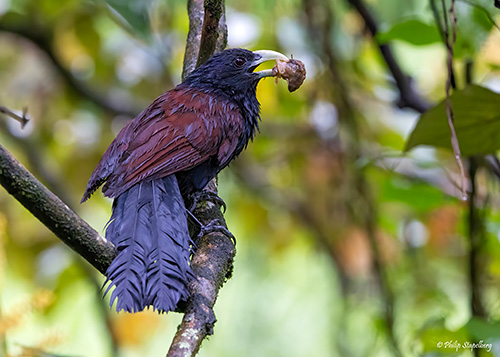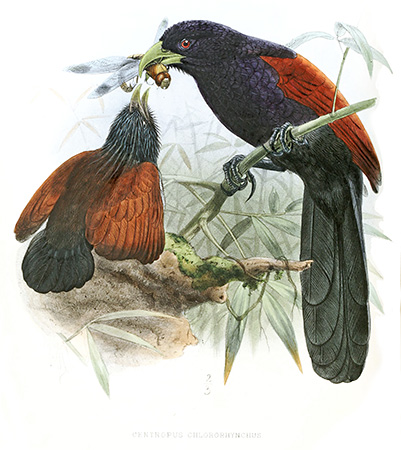
The female lays 2-3 chalky white eggs. The incubation is mainly performed by the female, but she if regularly fed at nest by the male. It also cleans the nest by removing the white fecal sacs while leaving the site.
From an observation, the incubation lasts about two weeks.
The chick has an ivory stripe on the bill, extending from the lores along the upper mandible to the tip of the bill. The lower mandible is brownish-black. We can see white feathers on head and neck, similar to individual hairs. About 12 days later, the white hair-like feathers are replaced by black feathers.
Both adults feed the chicks with frogs, skinks, moths, worms, snails and plant matter. About 12-13 days after hatching, the chick clambers out of the nest and spends a short time outside before to return to the nest.
PROTECTION / THREATS / STATUS:
The Green-billed Coucal is threatened by degradation of forests, through extensive clearance, especially in the wet zone where the species occurs. Logging, fuelwood collection, agriculture expansion, plantations, gem-mining, fire and settlements are the main threats, including in protected areas.
The species is declining in these areas, but competition with the Greater Coucal which is present in logged and disturbed areas, may be another problem contributing to this decline.
The size of the population is roughly estimated at 3,500/15,000 individuals, with fewer than 10,000 mature individuals.
The species is legally protected in Sri Lanka where it occurs in several national parks and reserves.
But currently, the Green-billed Coucal is listed as Vulnerable.
Fr: Coucal de Ceylan
Ang: Green-billed Coucal
All: Ceylonkuckuck
Esp: Cucal de Ceilán
Ita: Cucal beccoverde
Nd: Ceylonspoorkoekoek
Sd: ceylonsporrgök
Photographer:
Philip Stapelberg
GALLERY
Illustrator:
John Gerrard Keulemans (1842–1912)
Illustration’s origin: A History of the Birds of Ceylon. Volume 1
Text by Nicole Bouglouan
Sources:
HANDBOOK OF THE BIRDS OF THE WORLD vol 4 by Josep del Hoyo-Andrew Elliott-Jordi Sargatal - Lynx Edicions - ISBN: 8487334229
THE GREEN-BILLED OR CEYLON COUCAL CENTROPUS-CHLORORHYNCHUS BLYTH SRI LANKA'S RAREST ENDEMIC SPECIES
Nesting of Green-billed Coucals Centropus chlororhynchos in Sinharaja, Sri Lanka
Green-billed Coucal: threatened with extinction
Wikipedia, the free encyclopaedia
Green-billed Coucal
Centropus chlororhynchos
Cuculiformes Order – Cuculidae Family
INTRODUCTION:
The Green-billed Coucal is a member of the subfamily Centropodinae. These birds are nest-building, non-parasitic cuckoos, and are the largest species of the family Cuculidae.
The present species is endemic to Sri Lanka where it occurs in the wet zone forests, W, SW and S of the Central Mountains, up to 800 metres of elevation.
It feeds on small animals, insects, spiders and snails. It forages on the ground and in trees.
The breeding behaviour of the species is poorly known. The nest is described as a domed structure made of sticks, twigs, roots and grass, lined inside with green plant material. It is placed near the ground, about 1,5 to 3 metres above the ground, often in thorny plants or creepers. Both adults share the nesting duties.
The Green-billed Coucal is a rare species, threatened by habitat loss through clearance and degradation of forests, including in protected areas. The species is currently listed as Vulnerable.
DESCRIPTION OF THE BIRD:
Biometrics:
Length: 43-46 cm
Weight: Approximately 200 g
The Green-billed Coucal has dull black head, body and long, rounded tail. We can see a purple sheen on hind crown, nape, hind neck, mantle and throat, whereas the back shows dark metallic bronzy-green sheen.
The underparts and the black tail are glossy blue.
The upperwing is bright chestnut with darker tips and feather edges. Wing-coverts and scapulars are darker or of a dull maroon with black feather bases. On the underwing, the coverts are blackish but the flight-feathers are chestnut with blackish tips. The undertail is black.
On the black head, the feathers are longer and looser than on body.
The strong, down-curved bill is ivory/pale green. The colour varies from ivory during the breeding season to pale green after this period.
The eyes are red to reddish-brown.
Legs and feet are black.
Male and female are similar.

The juvenile resembles adults but its plumage may appear duller and streaked.
The bill is greenish with dark grey base and culmen.
The eyes are pale grey.
Legs and feet are dark pinkish/flesh.
RANGE:
The Green-billed Coucal is endemic to Sri Lanka where it is confined to a very few regions in the wet zone.
HABITAT:
The Green-billed Coucal is confined to the lowland forests and wetlands and is usually found in dense thickets and undergrowth.
The species is visible from lowland to 800 metres of elevation.
CALLS AND SONGS: SOUNDS BY XENO-CANTO
The Green-billed Coucal is difficult to see due to its secretive nature. It is usually identified and located from the loud, booming calls given both in the morning and the evening during which it usually calls for several hours, but also after a rain while climbing into a tree to dry its plumage. This sonorous, long-drawn call is described as “hoo-whoop-whooop” with lower last note. This call can be heard at a distance through the vegetation.
When the bird is disturbed or when perching after being flushed, it utters a monosyllabic note similar to the sound of a stone dropping into the water. It is described as “dhjoonk” and is given by both sexes.
We can also hear a deep, mournful call described as “hu-hu” and a single note call “chewkk”.
Both male and female call, but the male calls more frequently. The calls increase during the breeding period.
BEHAVIOUR IN THE WILD:
The Green-billed Coucal feeds on small animals such as beetles, butterflies, spiders, grasshoppers, snails and lizards found in the dense undergrowth of the forest.
This species is difficult to observe in the wild. It is believed to be primarily arboreal, but it forages both on the ground and in trees, about three metres above the ground.
It usually exhibits diverse feeding strategies, adapted to various habitats.
The Green-billed Coucal is a very shy species, more often heard than seen. It is known to dwell in the dense rainforest. They generally live in pairs and are monogamous.
Both mates defend the territory and build the nest together. The structure resembles a “rugby ball” with an entrance hole on the side. They are non-parasitic cuckoos as they build their own nest.
From an observation, the female incubates the eggs while the male feeds her. Both parents feed the chicks, but they never approach the nest directly. They fly first low around the tree and then, they climb through the dense foliage to reach the nest.
These birds can be seen perched on a branch, close to the foliage, enjoying the sun to dry their plumage after the rain. They are very beautiful with the bright chestnut wings fanned on each side of the black body.
The Green-billed Coucal is resident breeder in Sri Lanka.
The bird does not fly far and makes only short flights in flapping, gliding progression.
REPRODUCTION OF THIS SPECIES:
The breeding season takes place from April-May to July.
Both adults build the nest, a dome-shaped structure of about 60 cm tall and 45 cm wide. An entrance hole is visible on the side. It is placed near the ground to 3,50 metres above the ground in small tree, sometimes a thorny tree, within the vegetation of the crown, often creepers. The nest is made of twigs, roots and grass. It is lined inside with green leaves.

Adult (right) feeding a chick
John Gerrard Keulemans
(1842–1912)